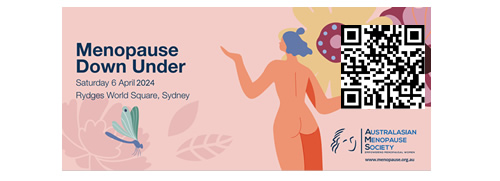The following topics concerning menopause treatment options may be found in the AMS Information Sheets.
Lifestyle and behavioural modifications for menopausal symptoms
A healthy diet and lifestyle, incorporating exercise, lowers risk for many health problems associated with ageing, gives you more energy, and improves quality of life. A healthy lifestyle may reduce menopausal symptoms including hot flushes and sleep disturbance.
![]() Lifestyle and behavioural modifications for menopausal symptoms353.11 KB
Lifestyle and behavioural modifications for menopausal symptoms353.11 KB
Menopause Management GP Tool
![]() A Practitioner’s Toolkit for the Management of the Menopause498.32 KB
A Practitioner’s Toolkit for the Management of the Menopause498.32 KB
![]() What is Menopausal Hormone Therapy (HRT)?
What is Menopausal Hormone Therapy (HRT)?
Oestrogen Only Menopausal Hormone Therapy
Women generally undergo menopause between the ages of 45 and 55 years. Around the time of menopause many women may experience symptoms such as hot flushes, sweats, vaginal dryness, loss of libido, irritability, sleep disturbance, and muscle/joint pains. There are a number of ways of managing these symptoms, but for those whose symptoms are troublesome and disruptive, oestrogen containing HRT may be considered.
![]() AMS Oestrogen Only Menopausal Hormone Therapy 397.21 KB
AMS Oestrogen Only Menopausal Hormone Therapy 397.21 KB
Combined Menopausal Hormone Therapy (MHT)
The menopause is the final menstrual period and usually happens between the ages of 45 and 55 years. Around this time, women may experience symptoms such as hot flushes, sweating, vaginal dryness, loss of libido, irritability, sleep disturbance and muscle/joint pains. Oestrogen therapy is the most effective means of treating these symptoms. It will also prevent bone loss. In a woman with an intact uterus, unopposed oestrogen therapy increases the risk of endometrial hyperplasia and cancer (1). Therefore, women who have not had a hysterectomy should take a progestogen as well to provide endometrial protection. Note that there is no therapeutic advantage of prescribing progestogen (either a progestin or natural progesterone) to women who have had a hysterectomy, (with the possible exception of women with symptomatic residual intra-peritoneal endometriosis) (2). In fact, there is a distinct disadvantage in terms of increased breast cancer and thrombotic risk and adverse changes in cardiovascular risk factors (3).
![]() AMS Menopause Combined MHT376.24 KB
AMS Menopause Combined MHT376.24 KB
Tibolone For Post-Menopausal Women
Tibolone is a type of hormone therapy (HT/HRT) designed to relieve menopausal symptoms and prevent osteoporosis (thinning of the bones) in post-menopausal women.
![]() AMS Tibolone for post-menopausal women223.05 KB
AMS Tibolone for post-menopausal women223.05 KB
AMS Guide to MHT/HRT Doses
This information has been developed as a guideline only to approximately equivalent doses of the different HRT products available. The intention is to help physicians change their patients to higher or lower approximate doses of MHT/HRT if needing to tailor therapy, or remain within the same approximate dose if needing to change brands of MHT/HRT.
NonHormonal Treatments for Menopausal Symptoms
This information sheet is intended for medical practitioners and nurses to help provide information to their patients.
Women sometimes seek alternative treatments for the symptoms of menopause if they have not found relief with lifestyle changes or their hormone replacement therapy does not work. Some may be advised against hormones because of a medical condition and others want to avoid them after hearing about health risks. This pamphlet includes summaries of studies of treatments prescribed by doctors "off-label" for relief of menopausal symptoms. (The main symptom treated by these medications is hot flushes/night sweats.) Off-label means use outside the specific purpose for which the drug was approved by Australia's medicines regulator, the Therapeutic Goods Administration. Doctors prescribing off-label have a responsibility to be well-informed about the product and base its use on scientific evidence.
![]() NonHormonal Treatments for Menopausal Symptoms596.01 KB
NonHormonal Treatments for Menopausal Symptoms596.01 KB
![]() Menopause - Non-hormonal Treatment Options
Menopause - Non-hormonal Treatment Options
![]() Menopause - Complementary Therapies
Menopause - Complementary Therapies

Note: Medical and scientific information provided and endorsed by the Australasian Menopause Society might not be relevant to a particular person's circumstances and should always be discussed with that person's own healthcare provider.
These Information Sheets may contain copyright or otherwise protected material. Reproduction of this Information Sheet by Australasian Menopause Society Members and other health professionals for clinical practice is permissible. Any other use of this information (hardcopy and electronic versions) must be agreed to and approved by the Australasian Menopause Society.
Content updated June 2023






